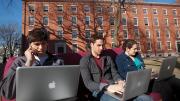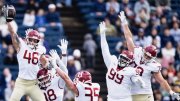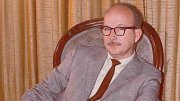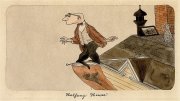In 1986, incoming freshmen did not receive Harvard e-mail addresses. The computer-science concentration was just five years old. Less than 9 percent of students reported significant work, study, or extended travel abroad before they graduated. (Today, that number is above 50 percent.) The undergraduate student body was 6 percent black and 4 percent Hispanic; only 40 percent received grant aid from Harvard. Upperclassmen were still assigned to the Houses based on their preferences, resulting in self-segregation in categories ranging from race and sexual orientation to varsity sports and the dramatic arts. And the student body was still roughly 60 percent male. Women had lived alongside men in the Houses and freshman dorms for 15 years, but “there were still so few female professors,” recalls Erika Christakis ’86, now co-master of Pforzheimer House. “There were so few female administrators.” Looking up at the dais on Commencement day, she recalls, “It was just a sea of men.”
The University now has women serving as president and executive vice president, as vice presidents, and as deans of several schools. The House populations are fully randomized; the last three years have even seen a pilot program in gender-neutral housing, including a few mixed-gender rooming groups. Students and faculty members have long since taken cell phones, computers, and the Internet for granted, giving rise to new worries: House masters and tutors fret that undergraduates spend too much time staring at screens at the expense of socializing in person. But they say e-mail emboldens meek students to contact professors, starting conversations that continue face to face during office hours. Professors experiment with new teaching formats: they tape lectures for students to watch before class sessions, which are then used for questions; or they require students to submit questions about the week’s reading in an online forum before each class, increasing accountability and engagement.
During the last 25 years, technological, economic, and cultural forces have shaped the student body into a more diverse population that approaches college life with intense focus. Today’s undergraduates are always on, always busy—and closer than previous generations to their parents: changes to which the College has had to adapt.
Who They Are
Harvard College has become vastly more diverse. The class of 2015, arriving this fall, has record numbers of black (9.8 percent) and Latino (10.3 percent) members. (The respective percentages in the overall U.S. population, according to 2010 census data, are 13 percent black and 16 percent Hispanic.) The share of undergraduates reporting Asian/Pacific Islander origin in 1986 was 8.9 percent; in the class of 2015 it is 18.7 percent. (Only 4.8 percent of the U.S. population falls into this category.)
Dean of admissions and financial aid William R. Fitzsimmons says there are still barriers to raising the representation of black and Hispanic students in particular. For poor, nonwhite students, he explains, “Every piece of the playing field is tipped against you.” Students may attend schools where the quality of instruction is so low, they would be lost as Harvard freshmen. Their schools may have eliminated extracurriculars such as music and sports. The admissions committee considers students’ records in context, but at a certain point, admitting very disadvantaged students may set them up for failure—and deny admission to others who have worked hard and excelled in higher-resource settings.
Though the proportion of students receiving financial aid has crept up over the years, the big jump came in 2008, with the introduction of a sliding scale under which families making up to $180,000 were asked to contribute no more than 10 percent of their annual income. Today, 61 percent of students receive aid; one-quarter of all students come from families with annual incomes less than $80,000. (Again, the student body does not mirror the U.S. population: nationally, median household income was $50,221 in 2009.) The College tracks those students’ experiences closely, and has found that they are no less prepared than their higher-income peers. Although the percentage of students required to take two semesters of expository writing has increased, “Students being overwhelmed the first year doesn’t seem to track with socioeconomic status,” says Jay M. Harris, dean of undergraduate education.
As for gender parity among undergraduates, that was not attained until 2007. The percentage of men had begun inching downward year by year after 1992, in what Fitzsimmons calls “a long, difficult battle”: Harvard’s reputation as a male-dominated institution deterred talented female students from applying. (Percentages in the admitted group tend to mirror percentages in the applicant pool. All along, he says, the policy has been “to admit the best people regardless of gender.”)
The undergraduate community also includes more international students—10 percent today versus 6 percent in 1986. (Some graduate and professional schools are much more international: at the Business School, the Graduate School of Design, and the School of Public Health, 32 percent of students come from foreign countries; at the Graduate School of Arts and Sciences, 36 percent; and at the Kennedy School, 42 percent.)
Some of the graduate and professional schools have also augmented financial aid. Notably, the School of Public Health offered aid to just 32 percent of its students in 1999, but assisted 61 percent in 2008—and the average package grew to cover 45 percent of costs, up from just 6 percent. As a priority of his presidency, Lawrence H. Summers designated scholarships for graduate study and public-service-oriented professional study. And from 2006 through 2009, the Graduate School of Arts and Sciences increased its support packages to bring them in line with what peer institutions offer; students in the social sciences and humanities, for example, are now guaranteed dissertation-completion fellowships and summer support for four years instead of two.
Even as the College has opened itself to students from other countries and a more diverse slice of America, it has become more selective: the acceptance rate was 16.1 percent for the class of 1989 (13,617 students applied), and dropped to a low of 6.2 percent for the class of 2015 (from 34,950 applications). As the process has grown more competitive, the admissions office increasingly chooses among candidates so uniformly excellent that there is little way to distinguish among them based on grades and test scores; deliberations frequently come down to what Fitzsimmons calls “the intangibles”: an alumni interview, a letter from a teacher, a guidance counselor’s recommendation.
Purposeful Pupils
Today’s students arrive at college eager to have their next four years, and beyond, planned from day one. Some administrators report that students choose even supposedly recreational extracurriculars strategically: assuming a leadership post in one group one year, moving to a different type of organization the next year—concerned all the while at least as much about what looks good on a résumé as about what would be fun or fulfilling.
This intense sense of purpose is attributable in part to economic factors. Sean and Judith Palfrey, the masters of Adams House since 2000, see September 11, 2001, as a turning point: a blow to the world economy that also shattered Americans’ sense of safety. Students who graduated in 2001 and before “saw the world as their oyster,” says Judy Palfrey. In the years since, a sense of vulnerability and fear has pierced that bravado: Bureau of Study Counsel associate director Sheila Reindl ’80, Ed.D. ’95, recalls being struck, in a recent discussion with students about their values, by how “the word ‘security’ came up a lot.”
Employers’ recruiting schedules have also crept earlier in senior year. “When I started here 15 years ago, the fall recruiting season was only for January graduates,” says Nancy Saunders, director of undergraduate career programming and advising for the Office of Career Services (OCS). “Employers seeking someone graduating in June didn’t even arrive on campus until January,” and it wasn’t uncommon for students to wait until after graduation to figure out what came next. The on-campus recruiting program has grown from 2,904 interviews in the 1985-86 academic year to more than 6,000 this past year; 80 percent of full-time hiring now takes place during the fall round, a switch that dates to the 1990s.
This “careerist” atmosphere may lead some students to focus so much on creating an attractive package for prospective employers that they lose sight of the point of a liberal-arts education. But some advisers say that urging students to ignore economic pressures is insensitive—particularly now that more of them come from low-income families and may find themselves helping to support parents or younger siblings immediately after, or even during, college.
Harvard graduates’ job choices are as much a reflection of the changing economy as of their own changing priorities. Of those members of the class of 2011 who answered the College's senior survey, 71 percent planned to enter the workforce right away. Of those, 41 percent planned to enter four business fields: financial services (17 percent), consulting (12 percent), sales and marketing (3 percent), and other business (9 percent). In 1986, when the College’s senior survey included only a single business category, 18 percent of seniors planned business careers.
Roughly equal numbers of students planned to enter communications, media, and the arts (10 percent in 2011; 12 percent in 1986), and information technology (3 percent in 2011; 4 percent working in “science/technology” in 1986). Seven percent of the 2011 graduating class planned to work in the nonprofit sector, a category that wasn’t listed in 1986. (All percentages for 2011 are based on the cohort entering the workforce right away, thereby excluding, for example, those who planned to attend graduate school.)
Fewer students planned to enter law (4 percent in 2011; 10 percent in 1986) or health and medicine (8 percent in 2011; 15 percent in 1986). But OCS director director Robin Mount notes that the office has changed the way it asks the question. The 1986 survey asked students their eventual career plans, regardless of the immediate next step—and that next step was often “undecided” or some short-term activity unrelated to the long-term plan. Now, students almost always know by senior spring what they’ll be doing after they graduate, for at least the next couple of years, and it’s what comes after—the long-term plan—that is the question mark; the College has stopped asking about eventual plans and now simply asks about the field of new graduates’ first jobs.
The Parental Prop
Those who work with students inevitably mention a major cultural shift: parents have become a bigger part of college life. When Judy Palfrey arrived at Radcliffe in the fall of 1963, parents’ attitude toward sending their children off to college was “I love you very much. Goodbye,” she recalls. That “goodbye” moment may be delayed until after college now; technology enables students to talk with parents daily—sometimes several times a day.
Although the phenomenon is not universal, it is common enough that administrators have become concerned about “helicopter parents.” The freshman dean’s office added sessions for parents at “Prefrosh Weekend” (the April visiting program for accepted applicants) after they began showing up along with their children. Dean of freshmen Thomas A. Dingman sees their influence on his academic advisees: “I’ll have a meeting with an advisee about whether he wants to drop a course, and he’ll walk out of here and he’ll be on his cell phone in the lobby with his parents to tell them what I said.”
Administrators report receiving more frequent calls from parents on their sons’ and daughters’ behalf. Dingman (who acknowledges placing calls on his own daughters’ behalf) worries about the consequences for students’ independent thinking: “The students are missing an opportunity to advocate for themselves. They don’t get familiar with their own voices, and they can think their own voices don’t even matter.”
Instead of revising their own research papers and applications for fellowships and graduate school, students report e-mailing them to parents for proofreading. The trouble with that practice? “Red ink can help you learn, rather than someone else cleaning it up for you in advance,” Dingman says. Students today feel “that there isn’t much room to make mistakes,” he adds: with productivity, efficiency, and perfection as goals, they fear that mistakes, dalliances such as hobbies, or even downtime itself, may hurt their chances for success in the job market, and in life.
Always Busy, Always Learning?
“I don’t think students are making choices,” Timothy McCarthy ’93, an adjunct professor at the Kennedy School and resident tutor in Quincy House, told Undergraduate columnist Casey N. Cep ’07 in 2007. “Instead, they are choosing to try and do everything.” (For more on the frenetic pace of student life, see “Nonstop,” March-April 2010, page 34.)
In a 2001 column, Arianne R. Cohen ’03 captured the pressure on students to accomplish more than humanly possible in a 24-hour day, detailing how she adjusted by cutting out sleep, and the consequences:
After a full night of procrastination and studying, I would collapse into bed around 4 or 5 a.m., only to drag myself back out of bed at 6:45 a.m. to make my 7 a.m. monitoring shift at the Malkin Athletic Center, where I would fall asleep every few minutes while sitting straight up on a metal stool for two hours, before heading off to class. Accordingly, I considered myself one of Harvard’s hardest-working, most self-sacrificing students.
Today’s students “seem to fill up every available moment,” says Dingman. The number of registered student extracurricular groups doubled between 1985 and 2010, to roughly 400. Professors and administrators report that today’s students spend less time on classwork and come to class less frequently—and are often sleep-deprived when they do. They increasingly operate on a 24-hour schedule: Lamont Library now stays open all night, and all the dining halls offer “Brain Break” (late-night snacks) five nights a week.
Professor of sociology and of medicine and Pforzheimer House co-master Nicholas Christakis notes that students give his undergraduate sociology course a difficulty rating of 3 (on a scale of 1 to 5). For this moderately challenging class, the students report spending an average of three hours per week on coursework outside class—and consistently complain about the heavy reading load. Christakis has little sympathy: “I’m old-fashioned in this regard. I think the primary reason you’re here at Harvard is to study and learn.”
In his 2006 book Excellence Without a Soul, McKay professor of computer science Harry R. Lewis, dean of the College from 1995 to 2003, wrote that students turn to “episodic frantic activity—studying, partying, exercising, organizing a road trip for some student group—as a way of avoiding the gnawing question: Am I doing what I really want to do with my college years, and am I heading where I want to go? In college, with its endless distractions, it is easy to find excuses for looking intensely anywhere but inside oneself.”
Even if these activities fill a recreational role, they are an important component of the student experience. “You can’t dismiss this as ancillary fluff,” says dean of student life Suzy M. Nelson. “Making connections when you get to campus, making friends—those are some of the most important things a freshman can do. You’re probably not going to be successful in the classroom unless that happens.”
Serving the Whole Student
Because today’s students are more diverse, busier, and more stressed by career concerns, the College has responded with more institutional supports, starting with freshman advising. Dingman recalls that when he was a student in the 1960s, an academic adviser would tell a student, “You’ve got four courses on your study card. See you later.”
Today, training for freshman advisers includes guidance on paying attention to students’ mental health, physical activity, nutrition, and social, family, and financial concerns—all factors that affect academic success. In recent years, the number of students per adviser has been reduced significantly to allow more frequent interaction. Peer advising fellows, upperclassmen assigned to each freshman entryway, are expected to spend one-on-one time with each student (and refer students to other fellows with relevant knowledge for subject-specific mentoring as necessary), in addition to planning group events for the whole entryway.
A particular concern is helping students from disadvantaged backgrounds adjust to life at Harvard, where they may be floored by what their friends take for granted, or feel alienated from classmates whose families have much more money. Training for House tutors, masters, and resident deans, and for freshman advisers and proctors, now incorporates these concerns—reminding administrators, for instance, that some students will not be able to afford to go home for Thanksgiving. Students from low-income families can get free tickets to campus events such as theatrical performances and House formals. (The financial aid office determines eligibility and notifies students confidentially.)
Students today are more likely to live on campus than ever: just 120 undergraduates chose to live off campus last year, compared to 500 in 1980. But social life, increasingly, may be moving off campus. Some House masters and administrators claim that the all-male final clubs have become more central to student social life in the last decade. Women have founded all-female variants (the Seneca, the Bee), and the Crimson reported in May that students were joining national fraternities and sororities in record numbers: 268 women rushed Harvard’s three sororities, and there is talk of adding a fourth to meet demand. (None of these groups are officially recognized because of their gender-exclusive nature.)
Despite a perception that binge drinking is on the rise, its prevalence is essentially unchanged, says Ryan Travia, who directs Harvard’s office of alcohol and other drug services. But there is increased concern about the problem, partly due to parents’ growing expectation that the College take care of their sons and daughters. Since Travia’s office was created in 2005, it has trained a network of 80 student peer advisers on drug and alcohol issues, and it funds the purchase of snacks and nonalcoholic beverages for student parties. The College also requires students to register room parties now, declaring how many guests are expected and whether alcohol will be present.
What would those who work with Harvard students wish for them in another 25 years? Sheila Reindl, of the Bureau of Study Counsel, hopes that, with renewed focus and proposed renovations, the Houses will become places where students more frequently experience “genuine connection” with others. Suzy Nelson, the dean of student life, hopes that Harvard becomes more of “a place where you meet people from different backgrounds and you really get to know them, and you don’t just stick with your own group.”
Thomas Dingman, the dean of freshmen, hopes that the trend of preparing for a job and professionalizing one’s life ever earlier will have begun to reverse itself. The college years, he says, are “an awfully early time in your life to be shutting off the chance to grow in some potentially exciting directions.”









